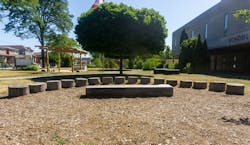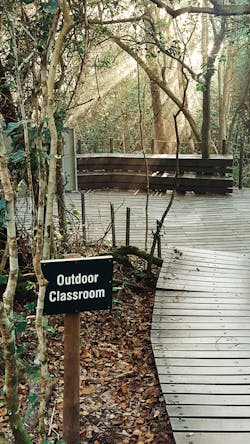For many years, it has not been uncommon for a school to take advantage of its entire campus and use the outdoor surroundings as an extension of the traditional classroom—play areas, gardens, nature walks, or just a change of pace from the four walls of a classroom.
In the Covid-19 era, outdoor spaces have become even more important as schools have had to make changes to create safer learning environments and protect students and staff from disease. Outdoor spaces can provide the additional area that schools need to achieve social distancing; in the outdoors, there is less transmission of the virus.
So schools that until now had not incorporated outdoor learning into their operations may be persuaded to do so.
“School districts across the United States can use their school grounds and local parks as safe outdoor learning environments to increase their capacity and options for social distancing as students return to school,” says Green Schoolyards America, an organization that seeks to create more green spaces on school grounds. “Outdoor spaces will reduce the burden on indoor classrooms while providing fresh air, hands-on learning opportunities, and the health benefits associated with increased access to nature.”
Outfitting the outdoors
The Nebraska Game and Parks Commission has identified several “must-have” features of an outdoor classroom:
- An entrance sign so that “everyone knows this is a dedicated space and everyone is welcome.”
- Seating or benches for students, visitors and teachers to sit while making observations, reading or doing other lessons.
- Border or fence “to ensure the safety of students as well as allowing the teacher to focus attention on lessons, not student safety.”
- Storage—a lockable space for equipment like shovels, rakes, and buckets. This can be inside a school or in a lockable shed.
- Tables for completing lessons and collecting data.
- A gathering space for the entire class to gather for a group lesson.
- Native plants; they will grow better and require less maintenance.
- Water; a water spigot is critical for garden maintenance.
Combating Covid
As part of the National Covid-19 Outdoor Learning Initiative, Green Schoolyards America is urging schools to establish outdoor learning areas not only to combat the spread of Covid-19, but also to improve the overall well-being of students.
“Investing in outdoor learning now, in response to the pandemic, addresses the urgent need for therapeutic mental health practices during this crisis and will also yield long-term health benefits for children,” Green Schoolyards America says.
The organization has compiled a list of elements that will help schools create an effective outdoor learning space.
- Low-cost seating solutions: existing seating already on campus. “Many campuses have existing seating areas such as lawns, picnic tables, bleachers, built-in amphitheaters, and concrete walls. This seating can be easily adapted to accommodate physical distancing.”
- Outdoor teaching supplies: clipboards, white boards, and a table for teachers; science, art, and math teaching tools; outdoor wi-fi access.
- Protection from the sun: tree canopies, shade umbrellas, tents, shade structures.
- Protection from rain and snow: rain shelters, weather-appropriate clothing; contingency plans to move inside when the weather is too wet or cold.
- Storage: supply sheds or bins; wagons for teachers to transport their supplies.
- Hand washing stations: portable stations or permanently installed outdoor sinks to so students and staff can clean their hands frequently.
- Accessibility: ADA-compliant paths of travel and seating in outdoor classrooms.
- Bathrooms: facilities directly connected to the schoolyard or otherwise easy to access from outside.
- Transportation: to ensure equity for schools that do not have adequate outdoor space onsite or at nearby parks. • Outdoor clothing: provide items for all children to protect them from the elements and ensure equity
The organization also recommends orienting outdoor classroom spaces to face north (away from the sun), so that students will not have sun in their eyes when looking at their teacher. Outdoor classrooms should be positioned far enough apart so that learning activities will not be audible or distracting for students in other classes.
For schools that do not have sufficient outdoor space on their campuses, administrators should determine if other nearby areas can be used as outdoor classrooms.
“Parks, public lands, closed streets, and other outdoor spaces offer valuable opportunities to extend learning beyond the school site into the neighborhood,” Green Schoolyards America says. “This is a particularly useful approach for schools with limited footprints, dense multi-storied classroom buildings, few existing outdoor facilities, or sites at which space is shared by multiple school partners with competing demands.”
Cleaning and sanitizing materials has become a greater priority because of Covid-19, so for outdoor programs, schools should use materials that can be thoroughly sanitized without falling apart. Schools should create systems for organizing, tracking, and sanitizing shared materials and keep a bucket of soap and water where materials can be placed when students are done. Use sanitizing wipes for the materials that cannot be submerged.
Another important step for schools creating an outdoor learning space is to prepare students for leaving the classroom. Teachers should let parents know that their children will be using the outdoors and that they may get dirty or wet. Remind parents that students to need to dress for outdoor learning with weather-appropriate weather and shoes.
About the Author
Mike Kennedy
Senior Editor
Mike Kennedy, senior editor, has written for AS&U on a wide range of educational issues since 1999.

